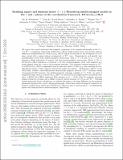Files in this item
Realizing square and diamond lattice S =1/2 Heisenberg antiferromagnet models in the α and β phases of the coordination framework, KTi(C2O4)2⋅xH2O
Item metadata
| dc.contributor.author | Abdeldaim, Aly H. | |
| dc.contributor.author | Li, Teng | |
| dc.contributor.author | Farrar, Lewis | |
| dc.contributor.author | Tsirlin, Alexander A. | |
| dc.contributor.author | Yao, Wenjiao | |
| dc.contributor.author | Gibbs, Alexandra S. | |
| dc.contributor.author | Manuel, Pascal | |
| dc.contributor.author | Lightfoot, Philip | |
| dc.contributor.author | Nilsen, Gøran J. | |
| dc.contributor.author | Clark, Lucy | |
| dc.date.accessioned | 2020-11-19T13:30:04Z | |
| dc.date.available | 2020-11-19T13:30:04Z | |
| dc.date.issued | 2020-10-23 | |
| dc.identifier | 271315196 | |
| dc.identifier | 2768359f-12a4-43f8-9a3d-f0233f67c05d | |
| dc.identifier | 85095433240 | |
| dc.identifier | 000619240300001 | |
| dc.identifier.citation | Abdeldaim , A H , Li , T , Farrar , L , Tsirlin , A A , Yao , W , Gibbs , A S , Manuel , P , Lightfoot , P , Nilsen , G J & Clark , L 2020 , ' Realizing square and diamond lattice S =1/2 Heisenberg antiferromagnet models in the α and β phases of the coordination framework, KTi(C 2 O 4 ) 2 ⋅xH 2 O ' , Physical Review Materials , vol. 4 , no. 10 , 104414 . https://doi.org/10.1103/PhysRevMaterials.4.104414 | en |
| dc.identifier.issn | 2475-9953 | |
| dc.identifier.other | ORCID: /0000-0001-7048-3982/work/83889303 | |
| dc.identifier.other | ORCID: /0000-0002-7012-1831/work/83889503 | |
| dc.identifier.uri | https://hdl.handle.net/10023/21015 | |
| dc.description | Provision of a PhD studentship to A.H.A. by the University of Liverpool and the Science and Technology Facilities Council (STFC) is gratefully acknowledged. The work of T.L. was funded by the University of St Andrews and China Scholarship Council (CSC) joint scholarship (201606280032). A.T. was funded by the Federal Ministry of Education and Research through the Sofja Kovalevskaya Award of Alexander von Humboldt Foundation. Work at St Andrews was supported by the Leverhulme Trust (RPG-2013-343). | en |
| dc.description.abstract | We report the crystal structures and magnetic properties of two pseudopolymorphs of the S=1/2 Ti3+ coordination framework, KTi(C2O4)2⋅xH2O. Single-crystal x-ray and powder neutron diffraction measurements on α−KTi(C2O4)2⋅xH2O confirm its structure in the tetragonal I4/mcm space group with a square planar arrangement of Ti3+ ions. Magnetometry and specific heat measurements reveal weak antiferromagnetic interactions, with J1≈7 K and J2/J1=0.11 indicating a slight frustration of nearest- and next-nearest-neighbor interactions. Below 1.8 K, α−KTi(C2O4)2⋅xH2O undergoes a transition to G-type antiferromagnetic order with magnetic moments aligned along the c axis of the tetragonal structure. The estimated ordered moment of Ti3+ in α−KTi(C2O4)2⋅xH2O is suppressed from its spin-only value to 0.62(3) μB, thus verifying the two-dimensional nature of the magnetic interactions within the system. β−KTi(C2O4)2⋅2H2O, on the other hand, realizes a three-dimensional diamondlike magnetic network of Ti3+ moments within a hexagonal P6222 structure. An antiferromagnetic exchange coupling of J≈54 K—an order of magnitude larger than in α−KTi(C2O4)2⋅xH2O—is extracted from magnetometry and specific heat data. β−KTi(C2O4)2⋅2H2O undergoes Néel ordering at TN=28 K, with the magnetic moments aligned within the ab plane and a slightly reduced ordered moment of 0.79 μB per Ti3+. Through density-functional theory calculations, we address the origin of the large difference in the exchange parameters between the α and β pseudopolymorphs. Given their observed magnetic behaviors, we propose α−KTi(C2O4)2⋅xH2O and β−KTi(C2O4)2⋅2H2O as close to ideal model S =1/2 Heisenberg square and diamond lattice antiferromagnets, respectively. | |
| dc.format.extent | 12 | |
| dc.format.extent | 8952835 | |
| dc.language.iso | eng | |
| dc.relation.ispartof | Physical Review Materials | en |
| dc.subject | QC Physics | en |
| dc.subject | QD Chemistry | en |
| dc.subject | Materials Science(all) | en |
| dc.subject | Physics and Astronomy (miscellaneous) | en |
| dc.subject | NDAS | en |
| dc.subject.lcc | QC | en |
| dc.subject.lcc | QD | en |
| dc.title | Realizing square and diamond lattice S =1/2 Heisenberg antiferromagnet models in the α and β phases of the coordination framework, KTi(C2O4)2⋅xH2O | en |
| dc.type | Journal article | en |
| dc.contributor.sponsor | The Leverhulme Trust | en |
| dc.contributor.institution | University of St Andrews. School of Chemistry | en |
| dc.contributor.institution | University of St Andrews. EaSTCHEM | en |
| dc.identifier.doi | 10.1103/PhysRevMaterials.4.104414 | |
| dc.description.status | Peer reviewed | en |
| dc.identifier.grantnumber | RPG-2013-343 | en |
This item appears in the following Collection(s)
Items in the St Andrews Research Repository are protected by copyright, with all rights reserved, unless otherwise indicated.

